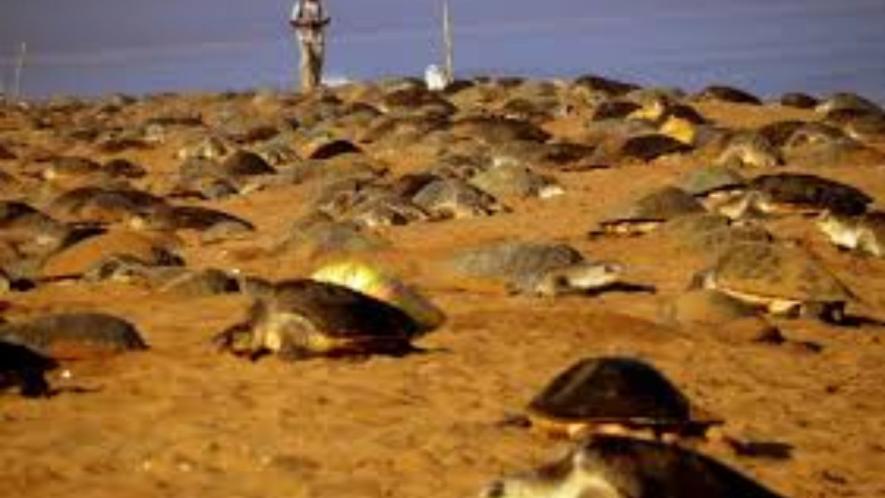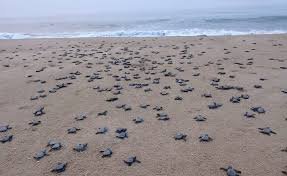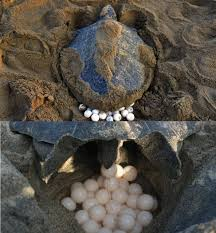Odisha: World’s Largest Rookery Gahirmatha Beach Turns Black as Lakhs of Olive Ridley Turtles Arrive

It was incredible and unexpected in a way when the marshy yet golden beach turned black with over one lakh Olive Ridley sea turtles occupying the major part of the beach for laying eggs in the pits.
We had travelled miles on the roads from Gupti to Rajnagar in Odisha’s Kendrapara district, sailing in boats negotiating some turbulence when the wild waves hit us as we were nearing Gahirmatha, supposedly the largest rookery in the world that attracts the Olive Ridleys from several coasts from as far as the Caspian Sea.
This was a spectacle at the Babubali sea beach in Gahirmatha wildlife sanctuary.
Before that, to our utter dismay, the beach was desolate till noon, as we had food at a sand-dune about 100 meters away from Babubali, which is virtually a camp for fishermen who had built over 50 make-shift shelters fortified by twigs and mud.
After lunch, a local man almost screamed in joy, gesturing at us to rush to the Babubali island. His body language reflected his ecstasy at the arrival of the turtles.
When we reached Babubali, the beach looked like it was enveloped by a greyish black apron with innumerable Olive Ridleys already stationed on their pits while more could be seen crawling up from the Bay of Bengal.

A Spectacle of Nature
Primitive or prehistoric OliveRidley sea turtles are viewed as a sister group of dinosaurs that are more primitive. Another hypothesis suggests that these turtles are more closely related to lizards of those times.
Olive Ridley sea turtles (Lepidochelys olivacea) have been making news to raise awareness about the necessity of preserving the habitat of these migratory guests who co-exist with humans in this beautiful planet.
Gahirmatha, undisputedly, is the largest known mass nesting rookery for Olive Ridley sea turtles in the world. The recent nesting decline at Gahirmatha is likely due to the unavailability of available nesting areas on the beach, which is often damaged due to the literal drifts from the sea.
Come October and before April, Gahirmatha becomes the major destination for the Olive Ridleys, where about 600,000 turtles come, although with some fluctuations.
The International Union of Conservation of Nature and Natural Resources (IUCN) perceives the Olive Ridleys being classed as endangered because of the extremely pitiable survival rate of the hatchlings that come out of the pits where each turtle lays 100 to 150 eggs.
Besides the predation on eggs, after the incubation period of 45 to 50 days, the eggs yield over 600,000 hatchlings that go back to the seas.
“Going by the research and IUCN, the rate of survival of hatchlings is one in thousand, a real cause of worry in years to come and that is an indication at the risk this species face regardless of the abundance in their arrival for laying eggs”, said Biswajit Mohanty, a frontliner in conservation of Olive Ridleys, who also heads Wildlife Society of Odisha.

Hatchlings take 25 to 30 years to attain maturity, as the females usually, and the turtles, again head towards the same place, such as Gahirmatha, to lay eggs where they were born. It can be said as their homing instinct.
Mohanty also told this writer that fluctuation in the arrival of Oliver Ridleys is also due to human intervention and factors like commercialisation for tourism. The flip side is that the demand for their eggs and their meat in many places like Kolkata and their skin remains a vital reason behind their indiscriminate killing.
“They are an integral part of the enrichment of the marine ecosystem, so considering their importance now, it is time to enforce stricter rules to protect them from gradual extinction” said Mohanty.
It can be assumed that tardy implementation of rules still are a key threat factor looming over Olive Ridleys.
The Odisha government has imposed a seven-month fishing ban in the Gahirmatha Marine Sanctuary, a habitat for the endangered Olive Ridley turtles. This ban, implemented by the state forest department, aims to safeguard the turtles during their annual mating and nesting season.
The fishing restrictions have also been extended to other key turtle nesting sites at the Rushikulya, Dhamra, and Devi river mouths. This prohibition, effective from November 1 to May 31, prohibits fishing activities, including operating mechanised trawlers and boats within 20 kilometres from the coastline stretching from Dhamra to Devi River.
The writer is a freelance journalist based in Odisha.
Get the latest reports & analysis with people's perspective on Protests, movements & deep analytical videos, discussions of the current affairs in your Telegram app. Subscribe to NewsClick's Telegram channel & get Real-Time updates on stories, as they get published on our website.
























